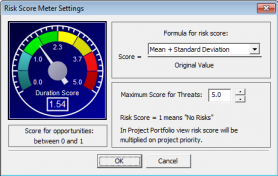What is Project Risk Score?
Project risk scores are an indicator, which show the level of project risk exposure. It is used to compare, prioritize and manage projects in your project portfolio. With project risk scores, we can identify those projects which could have the greatest impact on your ability to successfully execute the projects in your portfolio. Project risk score calculation based on qualitative or quantitative project risk analysis.
Calculation of Project Risk Scores using Qualitative Risk Analysis
Qualitative risk analysis is performed without analyzing the project schedules. For qualitative risk analysis you define risks the can affect the project with their probability and impact. Then you calculate severity or exposure of each risk by multiplying probability with impact. Individual risk severity or exposure is sometimes called the risk score, which is different than a project risk score. Then cumulative risk severity is calculated. This is a project risk score.
There are different algorithms of calculating project risk score. The risks can belong to different categories, such as schedule, cost, security, safety, quality, technology, public relations, and others. The same risk may affect multiple categories. Some categories may have higher weights than others. For example, safety could be three times more important than cost. These weights can be calculated by pairwise comparison on individual categories. This process is similar to what is used in analytical hierarchy process. Calculation of the project risk score is accounts with taking for the weights of each category.
Final project risk score can be calculated based on number (e.g. 1,2,3,4,5) or as percentage. It is usually normalized so it is consistent for all projects.
Calculation of Project Risk Scores using Monte Carlo Simulations
Quantitative project risk analysis is performed using Monte Carlo simulations. When Monte Carlo simulations are run, we can generate project level results for cost and schedule. These results are typically displayed as histograms or cumulative probability as well as generating other statistical measures such as mean, median, and standard deviation. While these indicators are an extremely valuable part of the analysis, they are of limited value when comparing projects at a portfolio level because differing scales of projects (differences in duration and cost). This requires a score that indicates the relative amount of risk that each project has.
In RiskyProject, we calculate project risk scores for cost or duration by dividing the original value for cost or schedule by the results of the simulation. The results of the simulation can include Mean + Standard deviation, or confidence levels (60th, 70th, … percentiles). A score of 1 would indicate no risk, < 1 opportunity, and > 1 threat. Maximum risk scores can set as whole numbers between 2-6 based on your preference. These risk scores are shown on risk meters found in the Project Summary view.
Project Risk Score and Project Priorities
To use project risk scores to compare relative risk across projects, we also need to account for the relative importance of your projects. The relative importance of projects is expressed as: 0-100%. When project risk scores are shown in portfolio analysis view, the project risk scores are multiplied by the project priority to provide risk scores that reflect both the relative amount of project risk as well as the relative project importance. This method of project scoring provides a useful method to extend your project risk analysis into a useful indicator that can be used as part of your portfolio management processes. Projects can be ranked based on their risk scores so that risks in projects with highest risk scores will have priority.






